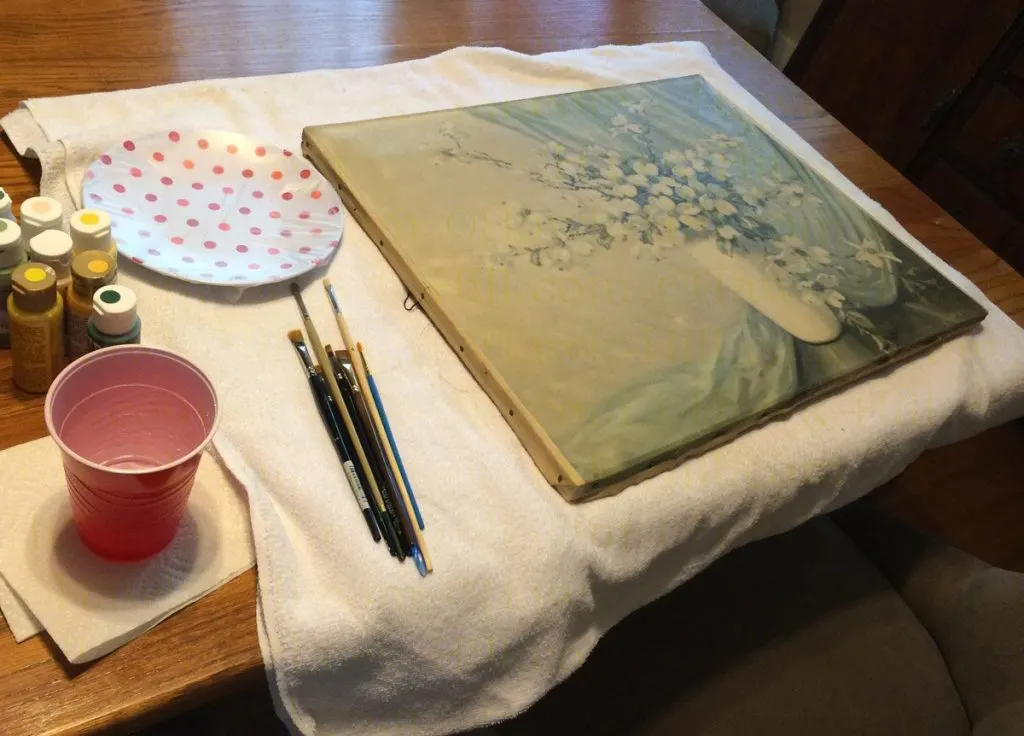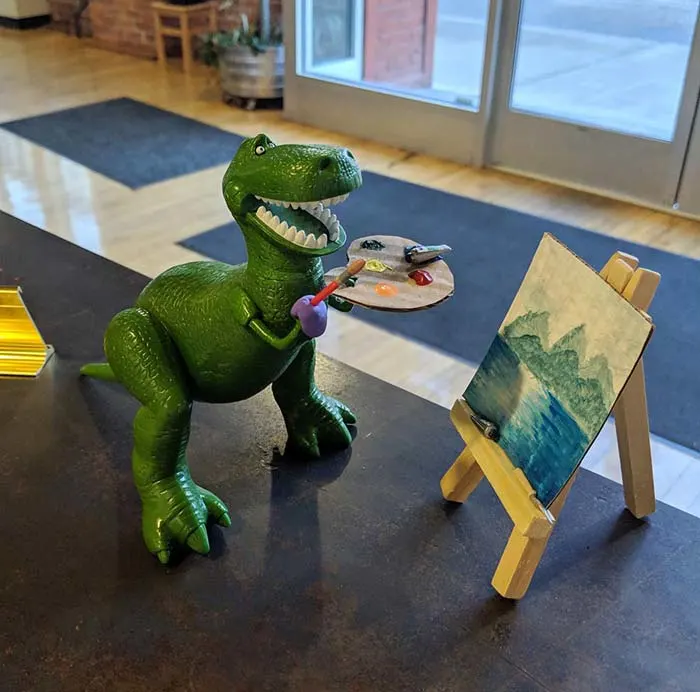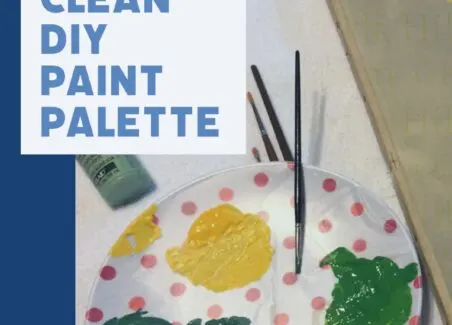Today, I wanted to share with you one of my best tips for painting, paint parties, and painting with kids: this easy hack for making paint palettes. This palette making method strikes a balance between disposable and reusable that those of us charged with cleaning up after ourselves or other artists will appreciate.
A few years ago, while frantically searching for a makeshift paint palette to follow a burst of creative inspiration, I decided to try covering a standard dinner plate to make a DIY paint palette. This technique worked so well that I’ve made my own paint palettes ever since. It helps me multipurpose what applies I already have so I can minimize my craft supply storage space and save money, while producing less plastic waste from my painting hobby.

It worked so well during that first DIY paint palette experiment that it’s been my go-to-paint palette since. It’s easy to mix paint on, totally protects the plate underneath, and when I’m done I can peel the film away from the plate, twist it in on itself (containing any wet paint), and continue the cleanup process quickly.
Though still disposable, I waste far less plastic with this method than I did when I used disposable plastic plates or art-store palettes. Plus, the rigidity that the plate adds under the plastic wrap works especially well for the technique of mixing colors by blotting colors together with aggressive brushstrokes into the paint.
The following section may contain affiliate links. As an Amazon Associate, we earn from qualifying purchases.
The Problem: cleaning up after painting can make a bigger mess
I can’t even tell you how many times, while cleaning up after a paint and sip party, I made a bigger mess cleaning up all that leftover paint than any of my painters left at their station!
Rinsing off a palette of acrylic paint in a sink can stain porcelain basins if they aren’t scrubbed down immediately, and dumping a palette in the trash after painting is wasteful (and sometimes results in paint dripping through the trash and leaking or even transferring onto the clothing of the person tasked with taking out the trash).
Many professional painters place their palette in an airtight container until the next painting session or, if they are finished with the paint palette, simply leave it to dry so it can be easily scraped clean once the paint has hardened. However, if you’re working in a temporary space like a shared studio, or are painting at home with kids around, it’s essential to clean up your space right away – often while the paint is still wet.
The solution: Adding a Peel-off film to paint palettes
My favorite acrylic paint painting tip that always creates converts after every paint party I that I host is using lightweight melamine plates covered with a thin layer of GLAD Press ‘N Seal. These plastic-covered plates create novice printer-friendly and kid-friendly DIY paint palettes that strike a perfect balance between reusable and disposable. Plus, they are a breeze to clean up!
What you’ll need:
- lightweight, easy to hold melamine plates
- GLAD Press ‘N Seal.
Optional substitutes:
Normally I provide a number of recommendations in my tutorials for products that also work in place of the recommended supplies, but in this case it’s worth hunting down these particular items. Here’s why:
GLAD Press ‘N Seal™ is a trademark product, and as it’s still rather new to the market, it has no generic version. This proprietary plastic film with a light adhesive on the back and a matte finish on the front is great for covering an acrylic or latex paint palette. The plastic doesn’t shift or move around- thanks to the adhesive- and the matte finish makes an ideal surface for blending colors on the tip of a paintbrush.

Melamine plates work better than disposable plates or breakable dinner plates because Press ‘N Seal™ adheres nicely to the nonporous melamine surface. If the paint palette is dropped during a painting session the melamine plate won’t break (and there’s a good chance, if you are working with quality viscous acrylic paints, there won’t even be any paint spilled!) In contrast, although the plastic film sticks well to ceramic plates, they’re heavy, hard to hold, and breakable. While paper plates are easy to hold and unbreakable, the plastic film won’t adhere to the porous surface.
TIP. You might be tempted to mix directly on a paper or wood pulp-based plate, however, a large amount of paint is wasted when blending on a porous surface, and paint tends to dry out much faster due to the fibers drawing moisture from the paint into the core of the disposable plate.
Eco-Friendly DIY Paint Palette
While a Press ‘N Seal-covered plate turned DIY paint palette certainly isn’t zero waste, a plate covered with plastic film is a more sustainable option than many of the typical options available for disposable acrylic paint palettes. Typically art stores sell disposable paint palettes made from rigid plastics which produce significantly more plastic waste than a thin layer of plastic film over a reusable plate.
Why amateur painters should use a paint palette:
If you’re new to acrylic painting, you may be familiar with painting in classes, paint parties, or paint and sip happy hours in which separate, tinted colors are provided to painters, along with instructions for exactly where to place them on the canvas. This method works well for teaching- especially groups of novice painters- but often creates a finished painting that lacks the highlights, shadows, and natural depth of paintings created by more advanced amateur artists and professionals.
Practice and study are undoubtedly the best ways to improve your painting skills (yes, the ability to make good art can be learned – contrary to popular opinion researchers have demonstrated that artistic skill can be learned and that even making “bad art” has major benefits for our brains. research journal source) but there are a few secrets techniques that can instantly improve your painting skills and finished paintings, and one of them is using a painting palette with lots of room to blend colors on a flat surface.
Avoid kid’s paint palettes that have shallow pools for individual colors- an amateur painting student needs a flat or slightly lipped painting palette where colors can be worked with and blended before being added to the canvas.
There’s a good reason that painters’ palettes have been used by artists for centuries – if not millennia. A painter’s palette allows you to blend, test, and make pools of custom colors before your paint ever reaches the canvas. With a good painter’s palette, the 8 or 12 colors of paint acrylic paint in front of you can be transformed into literally thousands of shades and hues that can be layered to create vibrance, highlights, and debts in your acrylic canvas paintings.
This technique is perfect for painting parties! Make cleanup a breeze after a children’s birthday party with a painting craft activity or after a grown-up sip and paint wine tasting and painting party. Just cover plates in advance with press n seal and remove the plastic after the party. For even easier cleanup- allow paint to dry on plastic overnight, then remove the plastic cover.

Tips for Cleaning Up Acrylic Paint
Acrylic paint is popular for its multiple uses, vibrant color, and ease-of-use for artists ranging from grade school children to professional artists. One of the perennial disadvantages, however, that acrylic paint has when compared to other paints is that acrylic paint has a tendency to stain- and, acrylic paint stains are epic. If not handled properly, stain from acrylic paint can resist all attempts at removal and ruin a piece of clothing with vibrant, removal-resistant pigment.
The thing to know about acrylic paint and removing stains is that acrylic paint is essentially plastic glue. Once dried, it’s stuck on for good. If acrylic paint dries on a nonporous surface such as glass or varnished wood, acrylic paint can often be peeled off with no residue, but when it comes to highly porous materials like fabric, denim, cotton or silk the stain from acrylic paint – if not handled properly and immediately – can become permanent with no effective removal technique.
Thanks for Reading!!!
I hope you can tell that I love DIY, researching the best affordable solutions for every-day problems opportunities and documenting / sharing solutions!🙌 Hawk-Hill.com is reader-supported.
☕ Hawk-Hill.com is reader-supported. If this article saved you time or money, please consider donating $1 to help me cover the cost of hosting this website OR If you appreciate this information and want to throw a “Thanks!” my way by buying me a coffee – I would Of Course appreciate it! :]
Reader Questions and Recommendations
Readers, do you have any favorite topics / posts? What would you like to read more about in the future? As I hope you can tell from this and other articles on my site, I really enjoy DIY / a good challenge, and I’m not afraid to roll up my sleeves to figure out a great, and hopefully simple 😁 solution. So please feel free to let me know in the comments below (or reach out via social media)!
Ok Really – I’ll try to wrap this up now😂
Finally, if you’d like to continue to learn about interesting DIY options as well as how YOU can tackle creative new projects consider checking out the latest and most popular articles listed on the Hawk-Hill Home Page. I’m always trying to enjoy and write about the creative side of life so please don’t be a stranger – check back often!😍
If you enjoyed this post you may also enjoy reading / perusing / devouring😊 one or all of these articles as well!

